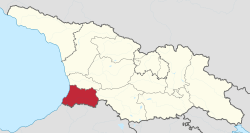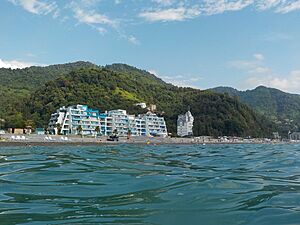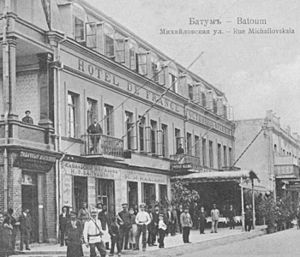Adjara facts for kids
Quick facts for kids
Adjara
აჭარა (Georgian)
|
|||
|---|---|---|---|
|
Autonomous Republic
|
|||
| Adjara აჭარის ავტონომიური რესპუბლიკა (Georgian) |
|||
|
|||
 |
|||
| Sovereign state | Georgia | ||
| Part of unified Georgian Kingdom |
9th century |
||
| Conquered by Ottoman Empire |
1614 |
||
| Ceded to Russian Empire | 1878 | ||
| Adjar ASSR | 1921 | ||
| Autonomous republic within Georgia |
1991 |
||
| Capital | Batumi 41°39′N 42°0′E / 41.650°N 42.000°E |
||
| Official languages | Georgian | ||
| Ethnic groups
(2014)
|
|
||
| Religion
(2014)
|
54.5% Orthodox Christianity 39.8% Islam 2.8% None 1.3% No answer 0.3% Armenian Apostolic Church 1.3% Other |
||
| Government | Devolved parliamentary autonomous republic | ||
|
• Chairman of
the Government |
Tornike Rizhvadze |
||
| Legislature | Supreme Council | ||
| Area | |||
|
• Total
|
2,880 km2 (1,110 sq mi) | ||
|
• Water (%)
|
negligible | ||
| Population | |||
|
• 2023 estimate
|
361,400 | ||
|
• 2014 census
|
336,077 | ||
|
• Density
|
124.6/km2 (322.7/sq mi) | ||
| GDP (PPP) | 2022 estimate | ||
|
• Total
|
₾ 5.91 Billion (2022) | ||
|
• Per capita
|
₾ 16,652 (2022) | ||
| HDI (2021) | 0.806 very high |
||
| Currency | Georgian lari (GEL) | ||
| Time zone | UTC+4 (UTC) | ||
|
• Summer (DST)
|
not observed | ||
Adjara (Georgian: აჭარა Ach’ara [at͡ʃʼara]), also known as Achara, is an autonomous region in the country of Georgia. It is officially called the Autonomous Republic of Adjara (Georgian: აჭარის ავტონომიური რესპუბლიკა Ach’aris Avt’onomiuri Resp’ublik’a [[unsupported input][unsupported input][unsupported input][unsupported input][unsupported input][unsupported input][unsupported input][unsupported input][unsupported input][unsupported input][unsupported input][unsupported input][unsupported input][unsupported input][unsupported input][unsupported input][unsupported input][unsupported input][unsupported input][unsupported input][unsupported input][unsupported input][unsupported input][unsupported input][unsupported input][unsupported input][unsupported input][unsupported input][unsupported input][unsupported input][unsupported input][unsupported input][unsupported input][unsupported input][unsupported input][unsupported input][unsupported input][unsupported input][unsupported input][unsupported input][unsupported input][unsupported input][unsupported input][unsupported input][unsupported input][unsupported input][unsupported input][unsupported input][unsupported input]]).
Adjara is located in the southwestern part of Georgia. It sits on the coast of the Black Sea, close to the Lesser Caucasus Mountains, and borders Turkey to the south. It's a popular place for tourists. Its capital city, Batumi, is the second largest city in Georgia. About 350,000 people live in Adjara, which covers an area of 2,880 km2 (1,110 sq mi).
The people who live here are called Adjarians. They are a group of Georgians. The name of the region can be spelled in many ways, like Ajara, Ajaria, Adjaria, Adzharia, Atchara, and Achara. Adjara's special status as an autonomous region is protected by an important agreement called the Treaty of Kars.
Contents
History of Adjara
Adjara has been part of Georgian kingdoms since ancient times. Greeks settled here in the 5th century BC, and later the Roman Empire took control. In the 8th century AD, it became part of the Kingdom of Abkhazia, which helped unite Georgia in the 11th century.
It is believed that Andrew the Apostle, an important Christian missionary, first brought Christianity to Georgia through the Adjara region.
Over the centuries, different empires occupied Adjara. These included the Achaemenid Empire (around 500 BC), the Seljuk Empire (11th century), the Mongol Empire (13th century), and the Timurid Empire (14th century).
Ottoman Rule in Adjara
The Ottoman Empire took over Adjara in 1614. The Ottomans allowed people to govern themselves and practice their own religions. However, over about 200 years, many Adjarians slowly became Muslims. The noble families were the first to convert. By the end of the 18th century, most Adjarians had adopted Islam.
Russian Empire Takes Over
In 1878, the Ottomans had to give Adjara to the Russian Empire after the Treaty of Berlin. This treaty allowed Adjarians to move to Turkey if they wished. Many Adjarians did move to Turkey.
Russian leaders tried to gain the loyalty of Adjarians. They supported the Russian Orthodox Church but also built mosques and schools for Muslims. Because of this, many Adjarians who had moved to Turkey later came back to Adjara. Under Russian rule, Adjara was known as the Batumi okrug.
Adjara Under Soviet Rule
In 1918, Georgia became an independent country called the Democratic Republic of Georgia. Adjara was part of it. After a brief occupation by the Ottoman Empire and then British troops, Adjara rejoined Georgia in 1920.
In 1921, the Soviet Red Army took over Georgia. Turkey also tried to invade Adjara again, but Georgians won the Battle of Batumi. Under the Treaty of Kars, Turkey agreed that Adjara would be part of Georgia, but only if the Muslim population was given special autonomy.
So, in 1921, the Soviets created the Adjarian Autonomous Soviet Socialist Republic within the Georgian Soviet Socialist Republic. This meant Adjara had some self-rule. It was the only autonomous region in the Soviet Union based on religion. However, the Soviet government discouraged religious practices. In the 1920s, some Adjarians rebelled against these changes, but the uprising was quickly stopped.
Independent Georgia and Adjara
After Georgia became independent from the Soviet Union, a leader named Aslan Abashidze took strong control of Adjara. He was first appointed in 1991. He used the civil war in Georgia to gain more power. He controlled the region's money and resources. His opponents said that elections in Adjara were not truly fair, and he controlled the news. He also created his own armed groups.
Even though the central government in Tbilisi had little say in Adjara, Abashidze said Adjara was not trying to separate from Georgia. He had a working relationship with Georgia's president, Eduard Shevardnadze.
After the Rose Revolution in 2003, President Shevardnadze was replaced by Mikheil Saakashvili. Abashidze did not agree with this change and declared a state of emergency in Adjara. He cracked down on people who opposed him.
In spring 2004, there was a major crisis as the Georgian government tried to regain full authority over Adjara. There were some clashes between Abashidze's groups and the Georgian army. However, large protests in Batumi against Abashidze's rule, along with demands from President Saakashvili, forced Abashidze to resign in May 2004. He then left for Moscow.
Saakashvili wanted Adjara to keep some self-rule. A new law was made to define Adjara's special status. Levan Varshalomidze became the new head of the government.
In 2007, the main court of Georgia moved its seat to Batumi. Also, in November 2007, Russia ended its military presence in Georgia by leaving its base in Batumi.
Today, Turkey still has some economic and religious influence in Adjara.
Geography and Climate

Adjara is located on the southeastern coast of the Black Sea. It stretches into the forested hills and mountains of the Lesser Caucasus. To the north, it borders the Guria region, to the east, Samtskhe-Javakheti, and to the south, Turkey. Most of Adjara is made up of hills or mountains. The highest mountains reach over 3,000 meters (9,800 feet) above sea level. About 60% of Adjara is covered by forests. Many parts of the Meskheti Range have temperate rain forests.
Climate in Adjara
Adjara is known for its humid climate, especially along the coast. It often has rainy weather, but there is also plenty of sunshine in spring and summer. Adjara gets the most rain in all of Georgia and the Caucasus. It is also one of the wettest temperate regions in the northern hemisphere.
No part of Adjara's coast receives less than 2,200 mm (86.6 in) of rain each year. The western slopes of the Meskheti Range can get over 4,500 mm (177.2 in) of rain annually. Along the coast, most of the rain falls as actual rain because of the subtropical climate. September and October are usually the wettest months. For example, Batumi gets about 410 mm (16.14 in) of rain in September.
The inner parts of Adjara are much drier than the coastal mountains. In winter, the higher regions of Adjara get a lot of snow, often several meters deep.
- Average summer temperatures:
- Lowland areas: 22–24 degrees Celsius
- Highland areas: 17–21 degrees Celsius
- Highest areas: Even lower temperatures
- Average winter temperatures:
- Coast: 4–6 degrees Celsius
- Interior and mountains: around -3–2 degrees Celsius
- Highest mountains: -8–(-7) degrees Celsius
Economy
Adjara has good land for growing crops like tea, citrus fruits, and tobacco. Because it's mountainous and forested, and has a subtropical climate, there are also many health resorts.
Leading crops include tobacco, tea, citrus fruits, and avocados. Raising livestock is also important. Industries in Adjara include packing tea, processing tobacco, canning fruits and fish, refining oil, and building ships.
The capital city, Batumi, is a very important port. It helps ship goods to Georgia, Azerbaijan, and Armenia, which has no coastline. Oil from Kazakhstan and Turkmenistan is shipped through the port of Batumi. Oil from the Caspian Sea (from Azerbaijan) comes by pipeline to Supsa port and then by train to Batumi for refining. Batumi is also a center for shipbuilding and manufacturing.
Adjara is the main area for tourism along Georgia's coast. It became more important for tourism after the Abkhazia region separated from Georgia in 1993.
Demographics
In 2014, the population of Adjara was 333,953 people.
Ethnic Groups
The Adjarians are a group of Georgian people. They speak local dialects of the Georgian language, and their written language is Georgian. Adjarians were once known as "Muslim Georgians." In Soviet times, they were listed as "Ajars" in a 1926 census. Later, they were simply counted as Georgians. Today, censuses in independent Georgia do not have a separate "Adjarian" category.
Other ethnic groups living in Adjara include Laz, Russians, Armenians, Pontic Greeks, and Abkhaz.
Religion
Religion in Adjara Orthodox Christian (54.5%) Sunni Islam (39.8%) Armenian Apostolic Church (0.3%) Others (5.3%)
When Adjara became part of the Russian Empire in 1878, Muslim Adjarians were allowed to move to Turkey. Russian authorities supported the Russian Orthodox Church but also built mosques and supported Muslim leaders to gain loyalty. Because of this, many Adjarians who had moved to Turkey later returned.
Even though Adjara's religious freedom was guaranteed by the 1921 Treaty of Kars, the Soviet government discouraged all religious practices.
After the Soviet Union broke apart, there was a rise in Islam in Adjara. However, later, Christianity grew strongly, especially among young people. Many saw converting to Christianity as returning to their ancestors' religion before the Ottoman conquest.
Still, there are Sunni Muslim communities in Adjara, mainly in the Khulo district. The Turkish Directorate of Religious Affairs is also active in Adjara. Many Adjarians are Muslims but consider themselves ethnic Georgians.
According to the 2014 census:
- 54.5% of Adjara's population is Orthodox Christian.
- 39.8% is Muslim.
- The rest include atheists, members of the Armenian Apostolic Church, and others.
In the capital city, Batumi, out of 152,839 people:
- 68.7% are Eastern Orthodox Christian, mostly belonging to the Georgian Orthodox Church.
- 25.3% are Muslims.
- There are also Catholic, Armenian Apostolic, Jehovah's Witness, Seventh-day Adventist, and Jewish communities.
In the second largest area, Kobuleti Municipality:
- 65.1% of the population is Orthodox Christian.
- 28.8% is Muslim.
Muslims make up the majority in the mountainous districts:
- 94.6% in Khulo Municipality
- 74.4% in Shuakhevi Municipality
- 62.1% in Keda Municipality
- 56.3% in Khelvachauri Municipality
| Municipalities | Orthodox Christians | Muslims | Irreligious | |||
|---|---|---|---|---|---|---|
| Number | % | Number | % | Number | % | |
| City of Batumi | 105,004 | 68.7 | 38,762 | 25.3 | 3,961 | 2.5 |
| Keda Municipality | 5,235 | 31.2 | 10,411 | 62.1 | 624 | 3.7 |
| Kobuleti Municipality | 48,696 | 65.1 | 21,573 | 28.8 | 2,728 | 3.6 |
| Khelvachauri Municipality | 18,618 | 36.3 | 28,841 | 56.3 | 1,816 | 3.5 |
| Shuakhevi Municipality | 3,532 | 23.4 | 11,193 | 74.4 | 76 | 0.5 |
| Khulo Municipality | 956 | 4.1 | 22,072 | 94.6 | 28 | 0.1 |
Traditional Public Festivals
Selimoba
Selimoba is a festival held in the village of Bako, Khulo Municipality, on June 3. It celebrates the life of Selim Khimshiashvili. During the festival, there is a concert with local groups and an exhibition of handmade crafts.
Shuamtoba
Shuamtoba, meaning "inter-mountain festival," is a traditional event. It takes place in the mountain pastures of two municipalities, Khulo and Shuakhevi, during the first weekend of every August. Activities include horse racing, an exhibition of traditional crafts, and a concert with folk music and dance.
Machakhloba
Machakhloba is a festival for the Machakhela gorge. It is held in the second half of September in the Machakhela gorge, Khelvachauri Municipality. The festival starts at the Machakhela rifle monument, continues in the village of Machakhispiri, and ends in the village of Zeda Chkhutuneti.
Kolkhoba
Kolkhoba is an ancient festival of the Laz. It is held at the end of August or beginning of September in Sarpi village, Khelvachauri District. During the festival, the famous story of the Argonauts is performed on stage.
Notable People
- Aslan Abashidze (born 1938), led the Adjarian government from 1991 to 2004.
- Memed Abashidze (1873–1941), an important political leader of Muslim Georgians.
- Tbeli Abuserisdze (1190–1240), a Georgian writer and scientist.
- Sopho Khalvashi (born 1986), a Georgian singer.
- Ahmed-Pasha Khimshiashvili (died 1836), a Great Ottoman Pasha.
- Selim Khimshiashvili (born 1815), a Pasha (Minister) for Ottoman and Russia Political Affairs in 1802.
- Zurab Nogaideli (born 1964), former Prime Minister of Georgia from 2005 to 2007.
- Levan Varshalomidze (born 1972), led the Adjarian government from 2004 to 2012.
- Fyodor Yurchikhin (born 1959), a cosmonaut.
See also
 In Spanish: Ayaria para niños
In Spanish: Ayaria para niños




